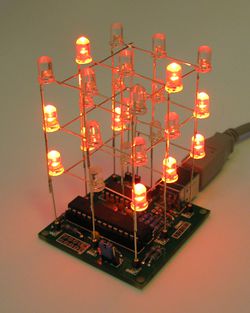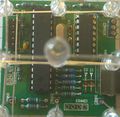LED Cube/en: Unterschied zwischen den Versionen
Marvin (Diskussion | Beiträge) K (hat „LED Cube“ nach „LED Cube/en“ verschoben) |
Marvin (Diskussion | Beiträge) Keine Bearbeitungszusammenfassung |
||
| Zeile 1: | Zeile 1: | ||
{{LED Cube Series/en}} | {{LED Cube Series/en}} | ||
<div style="border: 1px solid black; background-color: #f44">The LED Cube Series is a work in progress! Do not believe the content of these pages right now, they are probably about to change and may be untested. If you want to contribute, visit [[LED Cube/Contributing]].</div> | <div style="border: 1px solid black; background-color: #f44">The LED Cube Series is a work in progress! Do not believe the content of these pages right now, they are probably about to change and may be untested. If you want to contribute, visit [[LED Cube/Contributing]].</div> | ||
The LED Cube described on this page is a simple 3 * 3 * 3 single-color LED cube. | The LED Cube described on this page is a simple 3 * 3 * 3 single-color LED cube. | ||
Version vom 29. April 2012, 22:16 Uhr
| LED Cube Series | |
|---|---|
|
Chapter 1: Build Section 0: Preparation and Requirements Section 1: PCB Soldering Manual Section 2: Cube Soldering Manual Section 3: Assembly and Testing | |
|
Chapter 2: Play | |
|
Chapter 3: Learn |
The LED Cube described on this page is a simple 3 * 3 * 3 single-color LED cube. It is one of our easiest workshops, employing only through-hole components and thus specifically suited for introductory courses on soldering.
Getting Started
If you are interested in how they are built, you can read the PCB Soldering Manual for the PCB or the Cube Soldering Manual to learn how to construct the cube structure itself.
If you are interested in a more detailed view on the used software, check out Building from Source, where building the source code is explained.
If you want to learn how your cube actually works, read Understanding the Electronics. Also, you can write your own program to make your cube even fancier.
Accessories
Hefee has created a very cool Case for the PCB, which can be printed on many 3D printers.






